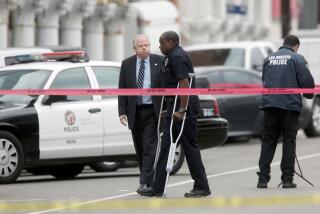Garcetti Ends 30-Year Case Against Pratt
Dist. Atty. Gil Garcetti said Wednesday that he will accept an appellate court decision upholding the reversal of former Black Panther Party leader Elmer “Geronimo” Pratt’s murder conviction, ending a criminal case that has been a part of Los Angeles’ legal landscape for more than 30 years.
“We will not proceed further with this case, either by rehearing, appeal or retrial,” Garcetti said at a news conference in his office.
Pratt, 52, spent 27 years behind bars, 25 of them in prison--the first eight in solitary confinement--for the December 1968 murder of schoolteacher Caroline Olsen and the severe wounding of her husband, Kenneth, during a robbery on a Santa Monica tennis court.
Pratt, a decorated Vietnam War veteran, has always maintained that he was innocent and that he was in the Bay Area attending party meetings when the Olsens were robbed and shot.
“A person was killed, and I was used as a scapegoat for the crime,” Pratt said Wednesday from his home in Morgan City, La., where he moved after his release.
He said the criminal justice system and the FBI’s secret COINTELPRO operations against the Panthers were responsible for his conviction and imprisonment.
“Mrs. Olsen died, I had to suffer for 27 years, her husband eventually died . . . from his wounds,” Pratt said. “It’s a shame no one is being held accountable.”
He said he was “very relieved that the vendetta from the D.A.’s office has maybe ended for me, but it hasn’t ended for so many others I know who are still behind those [prison] walls.”
Garcetti said Wednesday that during a three-year review of Pratt’s case, his office “found no evidence whatsoever that indicated that he was innocent.” Meanwhile, the prosecutor credited his office with turning up key evidence leading to Pratt’s release from prison.
Those comments angered Pratt’s lead appellate attorney, Stuart Hanlon, who said the district attorney “seems to be trying to take credit when he personally fought us tooth and nail. For him to try to take credit for anything good that happened to Geronimo is outrageous.”
Political observers said Garcetti’s decision will allow him to enter next spring’s primary election without the specter of the Pratt case hanging over his campaign.
Garcetti’s decision to drop the case “appears to be a matter of timing,” said Sherry Bebitch Jeffe, senior associate of the School of Politics and Economics at Claremont Graduate University.
“It makes sense to clear the plate,” she said. “It appears that many of the constituencies he needs--[liberal and African American voters]--are those that would care most about this case.”
She said Garcetti “certainly needed them last time around,” referring to the 1996 campaign when about 1,000 votes could have thrown the election to Deputy Dist. Atty. John Lynch, who was a virtual unknown at the time.
Garcetti told reporters Wednesday that he was ending the criminal case against Pratt for several reasons. The murder for which Pratt was convicted occurred more than 30 years ago, and most of the witnesses who could be used in a new trial are dead, making it “virtually impossible to retry this case,” he said.
He also noted that Pratt had spent 27 years behind bars--two in County Jail awaiting trial--and that “there is no reasonable likelihood of conviction.”
Pratt was released from prison in June 1997 after Orange County Superior Court Judge Everett W. Dickey ruled that prosecutors at his 1972 murder trial had concealed evidence that could have led to an acquittal.
A three-judge California Court of Appeal panel unanimously affirmed Dickey’s decision Tuesday, leaving Garcetti with the option of appealing to the California Supreme Court, retrying the case or dropping it.
A veteran deputy district attorney, who asked to remain anonymous, said Garcetti could have held Wednesday’s news conference a year ago.
All of the facts he mentioned as reasons for dropping the case were true a year ago, the prosecutor said.
Garcetti said Wednesday that his investigators found “the one key witness that the Court of Appeal as well as the Superior Court zeroed in on.”
He identified that witness as Julius Carl “Julio” Butler, the ex-Panther and former Los Angeles County sheriff’s deputy who first implicated Pratt in the crime.
Butler, however, had been the focus of several of Pratt’s earlier efforts to have his conviction reversed. Butler testified at Pratt’s trial that he had never been an informant for law enforcement.
But FBI documents released seven years after Pratt’s trial revealed that Butler had been providing information on the Panthers for at least three years before Pratt was convicted.
As Pratt’s effort to have his conviction reversed was making its way through the courts in 1996, Butler told a district attorney’s office investigator that he had been given $200 to buy a gun by a member of the district attorney’s staff.
The investigator also found that Butler was listed in an index of confidential informants maintained in the district attorney’s office--the same office that had prosecuted Pratt.
That index card, along with Butler’s activities as an informant for the Los Angeles Police Department and the FBI, became a critical piece of evidence in Pratt’s efforts to win a new trial.
While Garcetti credited the “professionalism and ethics of my staff” in their handling of the case, prosecutors at Pratt’s hearing attempted to show that the confidential informant card bearing Butler’s name was insignificant. They went to great lengths to argue that Butler was a “source” rather than an “informant.”
Judge Dickey asked in open court why it had taken 25 years for the card to surface.
Hanlon said Wednesday that he believes that the only reason prosecutors turned the card over to Pratt’s lawyers “is that their investigator, Brian Hale, wouldn’t hide it.”
More to Read
Sign up for Essential California
The most important California stories and recommendations in your inbox every morning.
You may occasionally receive promotional content from the Los Angeles Times.









